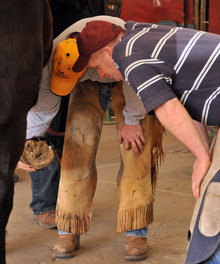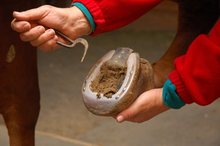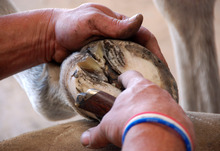The importance of a reliable farrier in your horse's life
Although the modern rider doesn't usually face a catastrophe at the loss of a horseshoe, Benjamin Franklin knew his history and his horses and as noted in his almanac, 'For the want of a nail the shoe was lost, For the want of a shoe the horse was lost, For the want of a horse the rider was lost.... to encourage people to take responsibility for the seemingly small, but important tasks in their daily lives, especially when it came to their horses.
Without doubt, a horse's hooves are one of the most important parts of the animal. Given a split hoof, nail prick, or stinky hoof, the first call should be to the farrier.

Farriers evaluating horse's hoof
Regularly scheduled farrier visits greatly reduce the potential for hoof problems.
© 2013 by April Raine
In fact, regular appointments with a competent farrier to keep hooves properly trimmed, make sure that shoes are fitted and attached properly, and assess the general hoof health of the horse will prevent most hoof problems from developing, thereby increasing the enjoyment and productivity associated with horse ownership.
Don't wait until a hoof problem develops to call the farrier. Many farriers are booked well in advance, and scheduling can take time.
In addition, a farrier who is familiar with the horse can instruct the owner or handler regarding general hoof care and what to do in an emergency situation. Since hoof growth varies with the season and general health of the horse, a competent farrier can help determine the best schedule for visits.
In addition to securing the services of a competent farrier, get to know your horse's hooves and establish what is "normal" for the horse. Picking the horse's feet on a daily basis or, at a minimum, before and after each ride, gives the horse a head start on healthy hooves.
Any small stones or objects that have become embedded in the feet can be removed, and any injuries noted for further action. Brushing the entire sole with a stiff brush allows a complete view and helps remove any traces of matter.

Picking the hoof
Pick your horse's feet daily if possible. Picking the feet before and after riding is an important habit to make.
Check the shoes for signs of loosening, shifting, or pulling away. Sometimes a shoe may need to be removed because it has shifted or the nails have come loose. Learning how and when to remove shoes can save the horse from unnecessary pain while waiting for the next farrier's visit.
Most farriers will be happy to instruct owners or handlers on how to check shoes and on how to remove them when necessary.
Get to know the horse's hooves by examining them on a regular basis. Become familiar with the condition of the frog, its texture and its firmness when healthy.
As the hooves are picked and examined, note the temperature of the feet so that when it deviates from the norm you will be aware that something unusual is going on.
A farrier will know how and when to trim the hooves. Generally, the hooves are trimmed so that the angle of the hoof matches the angle of the horse's shoulders and pastern. Most farriers recommend that toes should be kept as short as possible, and the toe or quarter should not have flares. Hoof walls should be trimmed evenly so that the bearing edges are level with the surface of the frog.
Once the hoof walls are trimmed, rasping both sides of the hoof wall across the bearing edges evenly will level the hoof properly.
If the hooves are cracking or scaling, a farrier may recommend a hoof dressing or sealer. In some cases, a farrier may recommend changes in diet or the addition of a supplement to promote better hoof health.
Making sure that the areas where a horse stands are kept clean, dry, and sanitary will help preserve good hoof health. Horses should never be left standing in areas that are wet, muddy, or unsanitary because of urine build-up.
Wet and unsanitary conditions may lead to a number of hoof health problems, including cracking and splitting, seedy toe, laminitis, and thrush. Not only do these hoof conditions and diseases lead to lameness, but in acute cases, may lead to the death of the horse.

Inspecting the hoof sole
Farrier examining the sole of a horse's foot that has a frog injury.
© 2013 by April Raine
A horse's hooves should be examined on a regular basis for any signs of punctures or other injuries. Too often, a horse comes up lame the day after a ride or other activity. If punctures and injuries are not spotted in a timely manner, abscesses and lameness may become ongoing problems.
Given the training and experience of a capable farrier, any problems related to the hooves of the horse will be met head-on, increasing the productivity and enjoyment of both horse and owner. While the owner or handler may be involved in day-to-day care of the horse's hooves and may learn how to do some trimming, a competent farrier should be part of the equation.
Nothing works better in maintaining good horse health than a viable partnership with a knowledgeable veterinarian and a capable farrier who get to know the horse and are available both on a regular and as-needed basis.
For these reasons, having the farrier on speed-dial will help insure that minor problems don't become major catastrophes -- with the horse's owner left to bemoan the fact that because of the loss of a nail, the shoe was lost, and because of the loss of the shoe, the horse was lost. That is a fate none of us wants to face!
